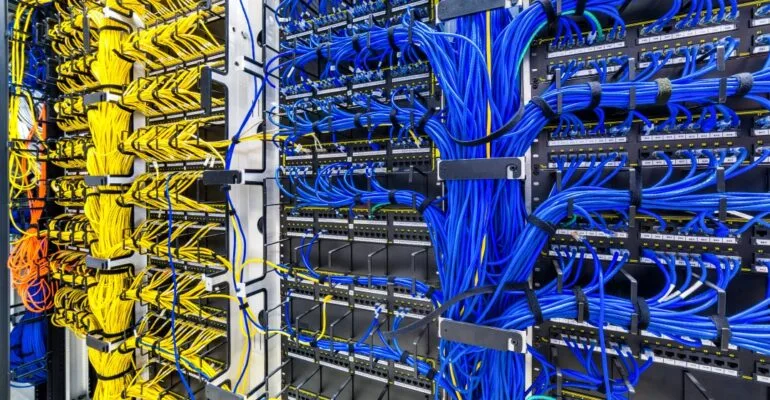Be it a commercial installation or a data center with rows of server racks and network cabinets substantial and well-planned cable management is a must to support a large number of data cables, fiber patch cords, power cords, and network devices required to operate the network efficiently.
This may not always be a simple task as we are likely working within a confined space without a great deal of room to move. That said some simple guidelines can be followed to make what could have been a difficult task a much simpler one.
The following highlights some well-used efficient tools and subsequent benefits of a properly installed cable management system.
Server Rack Cable Management Tools:
Horizontal cable managers are excellent as cable management for a range of cables, including copper, fiber, and coax patch cordage. This assists in ensuring that your cables are well-organized, protected, and relatively simple to allow moves, adds, and changes (MACS). Horizontal cable managers are made for rack-mountable applications in 1RU or 2RU designs. Finger duct and D-rings are also available with these horizontal cable managers for easier access to cables in your server rack.
Vertical cable managers work well to organize and hold cables to ensure proper airflow, avoiding overheating in a complex server rack environment. Overheating requires additional cooling. This is turn creates additional cost, and in a Data Centre or any environment, this is something you need to avoid. They also benefit installations where space is minimal as they can be designed and built into the server rack as an integrated solution. In addition, it a positive for a network that may require expansion in the future.
Cable trays are an effective solution to run a copper cable or fiber cabling in the horizontal link between the telecommunications outlet and server rack. A cable tray will allow for the cabling to be laid properly on the cable tray overhead in the ceiling to meet a standards-compliant installation. In addition, power cables can be run on an additional tray which will not only meet a standards-compliant solution, it will also meet the safety requirements of the installation. In particular mandatory separation from communications cabling and power cabling.
Server Rack Cable Management Benefits:
Improved system performance: server rack cable management allows the separation of power and data cables within the racks, which greatly decreases the chance for crosstalk and interference.
Enhanced availability: Effective server rack cable management allows easier access and identification for cables and IT devices.
Improved maintenance and serviceability: Effective rack cable management also ensures an easier and safer access path to individual components within the rack.
Increased cooling efficiency: let hot exhaust air out from the back, server rack cable management keeps cables organized and out of critical airflow paths.
Improved scalability: cable management in a server rack simplifies moves, adds, and changes, making it easier to integrate additional racks and components for future growth.
Standards Compliant: we are all aware an installation must meet standards requirements; however, standards compliance is a minimum requirement. The best practice is what we want to be aiming for in any cabling infrastructure installation.
Safety Requirements: this goes without saying that safety is the number 1 factor for any cabling work we do. Safety to yourself, your customer, and anyone who may enter an area where there is cabling. Compliant and best practice cable management allows for the correct separation between cabling types creating a safer environment for all.
Cost Reduction: another critical factor in any cabling installation. As stated above the right amount of airflow is critical in keeping costs to a minimum.
Server Rack Cable Management Installation Techniques:
Plan appropriately. Planning greatly assists in a simple or more complex server rack management process. Consulting a professional cabling contractor can always be beneficial.
Determine the routes for power and data cables. It needs to be identified if data and power cables are going to enter from the top or bottom of the server rack. Then plan the route to allow proper separation between the copper, fiber, and power cordage.
Identify cables. Colored patch cords are readily available and are a good way of identifying different applications by the use of color. A labeling system to allow easy cable and service identification should also be used.
Route and retain cables. Cables must be protected at points where they might encounter sharp edges or heated areas. Velcro ties and cable managers can be used for this. Avoid plastic cable ties as overtight plastic cable ties can damage the cable and negatively impact the network’s performance by altering the shape and integrity of the cable.
Secure cables. Cables and connectors should be secured to prevent excessive movement and to provide strain relief at relevant locations.
Avoid thermal issues. Ensure the airflow in the server rack is clear. Restrained airflow can cause temperature increases that can affect equipment performance and overall equipment lifespan.
Document and maintain organization. Documenting the complete infrastructure including diagrams, cable types, patching information, and cable counts are critical in managing and identifying cables when needed.
Summary:
If not installed correctly, server rack cable management can bring with it a series of problems that will lead to cable damage and failure. This ultimately will result in data transmission errors, performance issues, and system downtime. This equals unwanted costs. Not to mention the safety of all involved as stated above.
However properly planned and installed server rack management assists in the improved physical appearance of the installation, cable traceability and identification, improved airflow, cooling efficiency, minimizes troubleshooting time, improves safety, and reduces unwanted costs.
Written By: Trevor Kleinert_Bicsi Certified Trainer

